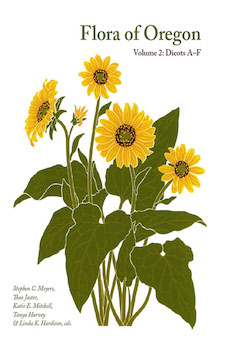Flora of Oregon Volume 2: Dicots A-F
Last Updated on February 4, 2024 by Tom Pratum

by Stephen C. Meyers, Thea Jaster, Katie E. Mitchell, Tanya Harvey and Linda K. Hardison, eds.
ISBN 978-1-889878-61-4.
BRIT Press, Fort Worth, Texas, 2021
This is the second of three volumes covering the vascular plants of Oregon, both native and naturalized. Its stated mission is “to engage researchers, plant growers, land managers, and nature enthusiasts by creating the basis of knowledge of Oregon’s plants.” This print book is supplemented by digital resources, including a mobile app and website (oregonflora.org). The website has taxon profile pages, interactive keys, distribution maps, and an interactive guide for growing native plants. The beauty of being connected to a digital version is that the flora is no longer entirely static and can be updated with new information. Unfortunately, the print volume went to press before some recent discoveries were included, such as Asclepias eriocarpa, A. incarnata and A. solanoana (Apocynaceae) and Marah fabacea, M. watsonii and Echinocystis lobata (Cucurbitaceae). As the digital flora is updated over time, you may want to note the additional species in the treatments in the book for field reference.
The introduction chapter describes the scope of work, conventions used, philosophy of taxonomic approach, and abbreviations and symbols. The following three chapters, illustrated with color photos, include: Landscaping with Native Plants, Insects as Plant Taxonomists, and Herbaria and a Modern Flora. The chapter on connections between floras and herbaria includes detailed instructions for naturalists to document significant discoveries with herbarium specimens that augment scientific knowledge.
As coordinator of the Bend Pollinator Pathway, I am particularly interested in the relationship of native insects to native plant species. The chapter Insects as Plant Taxonomists is an engaging read and a reinforcement of the work that we are doing in central Oregon to establish and connect native pollinator habitats. Organized by plant families within the different plant communities found across Oregon, this chapter is filled with colorful examples of coevolution between plants and their pollinators (both generalist and specialist). Sometimes this involves a trio of organisms that work together; for example, ants defend Boisduval’s blue butterfly larvae feeding on lupine against predator, and a caterpillar-specific virus protects Ceanothus plants from infestation by California tortoiseshells.
Native plant and insect enthusiasts will enjoy learning fascinating details about the life cycle of long-tongued bee flies, which are nest predators of solitary bees. Female flies deposit their eggs near the nest opening of a host bee. Upon hatching, the fly larvae enter the nest, feed on pollen, which was stored by the solitary bee to feed its own larvae and, subsequently, the flies devour the bee larvae. Fly eggs that don’t land inside the nest opening, hatch and, guided by scent, the bee larvae crawl into the nest.
It seems counterintuitive to discover that flowers that attract the most visitors are often the least likely to be pollinated. This is because species-specific pollen that is distributed everywhere is less likely to go where it’s needed. Specialist bee pollinators make it more likely that pollen goes to the receptive flowers.
Not surprisingly the threat of climate change looms large over insects. For example, the emergence of a specialist pollinator, the solitary red-tailed baby-blue-eyes spring bee, must coincide with the flowering of baby-blue-eyes (Nemophila). A warming climate could disrupt this synchrony, endangering the both species. This chapter has deepened my interest in native pollinator-plant relationships and fed my enthusiasm for learning more. I am grateful for the myriad of field observations that form the basis of this knowledge of the “little things that run the world.” More observation is needed because Oregon’s high level of insect and plant biodiversity depends on understanding and protecting native species.
The bulk of the volume (pages 61-751) includes dichotomous keys, distribution maps, and descriptions. Plant taxa are presented by family in alphabetical order (Aizoaceae through Fagaceae). There are 1,668 taxa in 39 dicot families, which is 30 percent more taxa than Volume 1. The major families of this tome are composites, mustards, stonecrops, heaths and legumes. For genera of more than four species, typically 20-25% are illustrated with a pen-and-ink line drawing. In most cases, the illustrations are of the plant’s habit, flower, and specific details that aid identification.
Appendices list cultivation features of over 300 Oregon natives appropriate for gardening and landscaping, native garden taxa that support beneficial insects, Oregon plants that are hosts to butterfly larvae, and specialist solitary bee species and their associated Oregon plant taxa. Finishing off Volume 2 are an illustrated glossary, references, author biographies, and an index of all scientific and common names.
—Basey Klopp, High Desert Chapter
